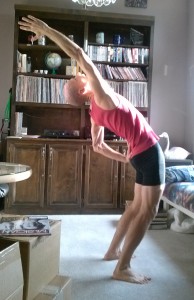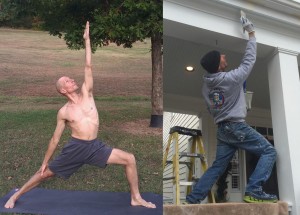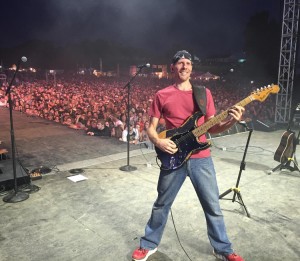Breathing
Two Years of Yoga – Part 1: the Physical Journey
This past Thanksgiving marks the second year anniversary of my yoga journey. It’s been an exciting year, lots of milestones and lots to be thankful for. At the one year mark, I decided to write a blog about my first year of yoga, so now that another year has come and gone I’d like to share how this transformational journey continues to evolve. For those of you who don’t know me, or didn’t read my first blog, I’ll start with a condensed version of how and why I got into yoga and then I’ll get into some of what I’ve learned during the second year (halfway through the writing of this blog I realized that it really wanted to be two blogs, one about the physical practice of yoga, and one about the mental and emotional benefits, so let’s start with the physical journey).
Throughout my adult life I’ve gone back and forth between two professions; music and construction. In 2011 I decided to go back into construction after many years of working as a touring musician. I was 43 years old and hadn’t worked in construction for about 15 years. Ouch, I was quickly reminded of how hard this work can be! Within a year I was having chronic shoulder and neck pain as well as relapses of tendinitis in my right arm from an old injury. Sometimes, after a few hours of work, my left shoulder would begin to hurt, the pain and stiffness spreading into my neck, ultimately limiting my range of mobility and causing intense pain. Once my shoulder and neck were “tweaked”, it might take several days to a week to subside. It was getting so bad that the condition could even be brought on by simply coughing or sneezing. I tried stretching, ibuprofen, lifting weights, but nothing worked, the condition was worsening.
Then one day a friend told me how he had used yoga to self heal an injury. I was intrigued. I began practicing with a yoga DVD (P90X Yoga) as well as putting together a few of my own short routines. I wasn’t consistent at first, but the ball was in motion. Then one day my wife, Kelly sent me a couple of YouTube video links. One was a 30 Minute Morning Yoga Class by Ali Kamenova (if you’re interested in exploring some great yoga videos, check out Ali’s YouTube channel). Almost instantly, this routine, and Ali’s style clicked with me, and soon this YouTube video had become my new best friend.
By one year into this commitment to self healing I was practicing Ali’s yoga routines almost daily, and the neck/shoulder pain and tendinitis were, for the most part, gone! Although they occasionally did show their face, the problems were minimal, and usually gone by the next day. There were a lot of other changes over that first year – a whole new sense of body awareness, breath, connectivity, improved attitude – I was stronger both physically and mentally, and had a growing sense of inner peace – all this from a 30 to 60 minute daily yoga practice at home. My first year of yoga was very exciting; self-healing my own injuries was very empowering. One of the biggest things I learned was the connection between the body, mind and breath, and I definitely felt an increased awareness of my physical and emotional state.
Figuring out what the body needs
When I first started practicing yoga, I was typically hitting the mat three times a week, occasionally  four. By the end of that first year it was almost daily, and I often found myself struggling to figure out what my body needed on a daily basis, which class to choose, what type of flow, how to alternate routines to target different parts of the body, etc. Maybe a certain area of my body was holding extra tension and required specific attention. I was also exploring how to build my day around my practice (to ensure it happened daily) and what clothing was most comfortable. Over the second year of practice, I gradually found answers to many of these questions.
four. By the end of that first year it was almost daily, and I often found myself struggling to figure out what my body needed on a daily basis, which class to choose, what type of flow, how to alternate routines to target different parts of the body, etc. Maybe a certain area of my body was holding extra tension and required specific attention. I was also exploring how to build my day around my practice (to ensure it happened daily) and what clothing was most comfortable. Over the second year of practice, I gradually found answers to many of these questions.
Creating a space for yoga
In order to practice yoga every day I believe you have to build it into your daily routine in a way that is sustainable, and this is different for everyone. I’ve learned that I don’t have the energy or focus for a challenging yoga sequence by the time I get home from work, so it’s pretty much a morning practice or nothing. For a while, I tried hitting the mat shortly after getting out of bed, and this was a struggle as my body was too stiff and I seemed to lack energy. Gradually, my schedule evolved into waking up around 5:00 AM, eating breakfast, doing a few other things around the house to kind of wake things up a bit, and then starting my practice at the last minute possible before leaving for work (allowing maximum time for digestion). On the weekends I find myself practicing much later in the morning and my body seems to like that a little better, but the compromise during the work week is essential. I think the key is to make a commitment to a daily practice, and then build the practice into your daily routine.
Types of routines:
I love a strong, moderate paced power yoga class, 50 to 60 minutes in length, with lots of warriors, backbends, twists, hip openers, and core work, and I do these as often as possible. However, sometimes my body wants something different. On some mornings I feel a little beat up from the workday before, so I might do a less intense routine that focuses on flexibility. I use these classes to take the edge off of whatever pains and tweaks I might wake up with and to prepare my body for another day of life’s abuses. Do you ever wake up feeling really tight, achy, and just really beat up from head to toe? Well even with all this yoga I still have days like that, too. On those mornings I try to do very easy, therapeutic routines, maybe 20 to 30 minutes in length with mostly seated poses. And then some days the body just wants a complete rest! Our physical state seems to fluctuate, going from higher to lower points of energy and stability, so it’s important to listen to your body; it is speaking to you and will tell you what it needs.
Staying Loose
Loosening up, tightening up, loosening up, tightening up…this seems to be a pattern in my life. I get all stretched out with a wonderful morning yoga class, and then sit in my car for an hour drive to work. Sitting in traffic sucks, and boy, will that tighten you up! Then there’s the repetitive motion of the job itself. Throughout the day, I’ll throw in a few poses, almost always right before lunch, and then again at the end of the day right before the afternoon commute. Even just a couple of forward folds and a standing side stretch can work wonders.
Making the body more efficient and workplace yoga
My job as a painter and drywall repairman is very physically demanding and requires a lot of sustained, awkward body positions. Working over head, crouching, kneeling, climbing up and down ladders, painting with a brush or roller for hours…did I mention sitting in traffic? No matter what you do for work; it will take its toll on the body. This is where yoga comes in. For every task that stresses the body, there’s a pose or group of poses that will counter it.
Painting and/or repairing ceilings place more stress on the neck and shoulders than almost anything else I do. Over the last two years I have greatly increased my flexibility in that region with backbends, twists, and shoulder openers. This work still takes its toll, but much less so because of my increased range of motion. Work that is low to the ground, like painting baseboards, is also quite taxing. You’ve  either got to sit, kneel, crouch, or lie on your side. I find myself sitting crosslegged to do a lot of this work, kneeling (with knee pads), or even squatting, and this requires open hips and loose hamstrings. Hip openers and hamstring stretches improve the ability to sit or kneel for extended periods of time. I’m constantly going from standing, to crouching, to climbing ladders, and this is where all the core work really pays off. Working over head or standing on a ladder requires the ability to balance and an awareness of my body in space. Balancing poses greatly help (if you want to get a sense of where you’re really at, try closing your eyes during tree pose!). When I perform music, I might be playing guitar and singing continuously for an hour or more, and this can be just as demanding as painting a house. All the muscles that get used and abused by performing music are stretched and strengthened by my yoga routines.
either got to sit, kneel, crouch, or lie on your side. I find myself sitting crosslegged to do a lot of this work, kneeling (with knee pads), or even squatting, and this requires open hips and loose hamstrings. Hip openers and hamstring stretches improve the ability to sit or kneel for extended periods of time. I’m constantly going from standing, to crouching, to climbing ladders, and this is where all the core work really pays off. Working over head or standing on a ladder requires the ability to balance and an awareness of my body in space. Balancing poses greatly help (if you want to get a sense of where you’re really at, try closing your eyes during tree pose!). When I perform music, I might be playing guitar and singing continuously for an hour or more, and this can be just as demanding as painting a house. All the muscles that get used and abused by performing music are stretched and strengthened by my yoga routines.
Breathing is the only way to deepen our practice
Anyone who has delved into yoga, even just a little bit, knows the emphasis placed on breathing. When we breathe deeply, with complete inhalations and exhalations, our body receives this as a signal to relax and to let go of tension. Sometimes I become aware of growing tension, and a few focused deep breaths almost always help to relieve it. If I do something that aggravates or tweaks a muscle, breathing can help to minimize, or even reverse what might otherwise become a runaway problem. As a chronic sufferer of migraines, I’ve learned that deep breathing can be a very powerful tool. And deep breathing can be especially helpful in dealing with the simple stresses of everyday life, arguments, traffic jams, etc.
I’ve learned so much in these last two years about how my body works, what it needs, how to use yoga to become less prone to injury, self heal injuries, and to optimize my physical and emotional well-being. My yoga practice, along with healthy eating is my own personal healthcare system. I believe it can have a powerful effect on anyone, and the best part is, it’s never too late to start. The transformational effects of my practice go way beyond increased strength and flexibility, and part two of this blog will delve into the positive effect it can have on mental and emotional wellness. As my initial exploration of yoga was centered on fitness, as it seems for many, I wanted this blog to partly serve as an inspiration or catalyst to those who are curious about it, or just getting started with their own practice.
Yoga practice seems to be dominated by women, and I think a lot of men don’t get into it because they don’t really understand what it can be. A big misconception among many who have never practiced yoga is that it’s all about meditation, or just for “stretching”. While it does include those things, the right kind of yoga routine can be as ass-kicking as any workout you’ll ever do. At its core, yoga is really about self exploration, and the breath, but it can also be an amazing physical fitness program. And with that, I’ve got to get going. It’s almost time for work and I’ve got to go hit the mat!
Here’s some photos my wife took during one of my recent yoga sessions (click or swipe the arrows to see all the photos): the before and after shots show my progress from one year ago.
[wowslider id="8"]
